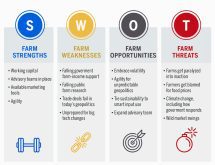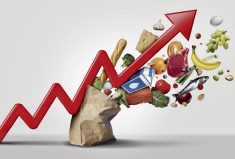In September, I challenged farmers to think about how Canada’s agricultural production should be branded. I questioned how consumers and foreign buyers view the commodities we produce. And most importantly, I wanted every farmer to ask themselves if production practices they use add or diminish that brand.
That column upset some farmers. Readers felt my column was too negative and I should focus on the positive. I was told that farmers are producers and have enough to worry about just producing their crops. A number also told me agriculture does not need a brand.
Read Also

The big squeeze: How to be fair to siblings during farm succession
Managing sibling business relationships on family farms.
But the most common feedback I received was to ask what the point of the article was. That question deserves an answer.
Farmers are CEOs
Governments, educational institutions, farm organizations, and farmers themselves have worked hard to change the image of farmers from being simple producers of agricultural commodities to being businessmen and women. I would take this even a step further. Farm owners/managers are, in fact, CEOs of businesses.
Most farmers are managing multi-million dollar operations when you total their investments in land, equipment, assets, inputs, and the resultant production. This is much more than the average Canadian business person is responsible for.
A CEO is ultimately responsible for everything a company or business does. Typically, the CEO delegates much of the daily operations of a business to staff and lower management. However, there are some duties which simply cannot be delegated. Number one is the development of a vision and strategy for the business.
The Corporate Finance Institute lists eight duties of a CEO, and I wonder how many CEOs of farm businesses are fulfilling the following three:
- Maintaining awareness of the competitive market landscape, expansion opportunities, industry developments, etc.
- Assessing risks to the company and ensuring they are monitored and minimized.
- Communicating, on behalf of the company, with shareholders, government entities, and the public.
Global agriculture is changing rapidly. On September 21, Dave Harding, the corporate communications manager for CoBank, a U.S. co-operative financial intuition, issued a news release detailing a $400 million chicken complex which Costco is building in eastern Nebraska. This facility will allow Costco to grow and process 100 million chickens annually, enough to meet one-third of its rotisserie chicken needs.
The news release gave three reasons why Costco has decided to expand into the primary production of chicken: cost control (Costco expects to save 10 to 35 cents per bird by raising and processing in-house), surety of supply, and visibility up the chain. By raising their own chickens, Costco can ensure a lower-cost supply of chickens which they are sure are grown to meet the promises that their brand makes to customers.
On the same day the South China Morning Post reported: “Russia has made one million hectares (2.5 million acres) of arable land available to foreign investors.” Other media outlets around the world have confirmed this offer and it is expected that up to half of the land will go to Chinese interests.
This offers follows a 2015 agreement with the government of Zabaikalsky Krai, one of Russia’s poorest regions, which saw a private Chinese company lease 1,000 square miles of arable land bordering China for the next 49 years.
And also this fall, Canadian grain producers received a huge reprieve when Peru delayed the implementation of changes to the phytosanitary requirements for Canadian wheat. Peru had applied to the WTO for the changes because of their dissatisfaction with the weed seeds present in Canadian wheat shipments. Those import restrictions were to have been introduced on August 1, 2018.
Fortunately, Peru has agreed to delay the change to export certification requirements for Canadian wheat until early 2019. But unless our Canadian grain agencies and government can resolve this issue with Peru, Canadian wheat growers could face the real possibility that we could lose our fourth-largest wheat market, which buys about a million tonnes of Canadian wheat a year.
Faced with the prospect of a major retailer of their product vertically integrating to produce their own goods rather than outsource, or faced with new competitors who can produce at a significantly lower price, or faced with the prospect of losing markets because of dissatisfaction because of their product standards, the CEO of any company would be working on strategic plans to deal with such disruptions.
Yet it seems Canadian grain farmers continue to view their market as the pit at the local elevator. They fail to realize that most grain traders are merely wholesalers and retailers of the products we grow and produce. Few of the grain companies that farmers deliver to are the end-users or consumers of the grains we produce and that we market through them.
Marketing is essential!
Imagine if you were producing toothpaste. As CEO, who would be the primary target of your marketing campaigns? Are TV ads for toothpaste appealing to the consumer or to the Walmarts, Rexalls, and other retailers of toothpaste? Is not the primary focus on the consumer who will be buying the toothpaste? Yes, it is important to secure shelf space, but shelf space is irrelevant if there is no consumer demand for your toothpaste.
To successfully sell the toothpaste in a market full of toothpaste brands, you must have strategies for product differentiation, consumer awareness, consumer feedback, and pricing. As the toothpaste company CEO, that is primarily your job: to develop such strategies.
Yet to most farm commodity producers, marketing only means price determination. How many marketing courses have you attended where consumer feedback is on the agenda? We only hear about options and contracts, forward pricing and hedging.
Many producers are irate over the marketing activities of companies that promote GMO-free, hormone-free, gluten-free, pesticide-free, naturally produced — the list goes on and on. But these companies have listened to consumers, and are producing and branding products that consumers are asking for.
Such branding does not guarantee the product the consumer wants is superior nutritionally, or that it is healthier, environmentally friendlier, or even produced in a more sustainable way. You can even question the ethics of such marketing tactics for products like gluten-free water or non-GMO vegetables if marketing is suggesting their product is free of something that does not even exist.
But you cannot question why it is being done. The goal of most businesses is to make a profit, and branding and marketing works. By targeting consumer demands, a company can earn more of the limited consumer dollars in a very competitive marketplace.
This is even truer in today’s commodity grain markets. The world has ample supplies of grain so buyers are selective. Patriotism has displaced globalism so grain markets have to deal with increasing trade barriers. Moreover, buyers of grains have become much more selective and demanding in quality and specs.
Unfortunately for grain farmers, many of our customers are overseas. For most producers, there is no direct customer feedback or even direct sales opportunities. So who should fulfil the marketing role on behalf of Canadian growers? Grain companies and traders?
Well, many of the grain companies are now multinational. Their business mission, like any company’s, is to maximize profits. Their buy and sell decisions are not based as much on patriotism or country of origin as on availability, logistics and price. If a marketer can make more money trading South American grains than Canadian grains to a customer with no additional risk, what grain do you think will move first?
Or should it be the role of our commodity boards, quasi-government agencies, or government itself? Marketing is not cheap and it is time-consuming. Many farmers dislike the check-offs required to fund marketing efforts like the overseas trips taken by such agency or organizational personnel, especially if farmers do not see immediate results from such marketing activities.
By default, Cereals Canada has likely become the primary marketer of Canadian grains. And they are doing a good job of monitoring and selling the crop after it is harvested. Their trade missions interact with traditional buyers and relay to the buyers the quality parameters of the harvest. However, I wonder if they have the resources available to actively seek new markets. And I question if Cereals Canada is providing enough feedback to producers from the consumers of our grains. As CEOs, farmers need this information! We need to know what consumers want and we need to know the reason for regulatory changes, not just notification of future grading and varietal changes. Marketing is not just selling, but telling as well.
Do you know what our brand is?
Most importantly, you as the CEO have a role to play. You need to understand what the brand is and to provide input as to what you believe the brand should be. That is what I wanted you to think about in the September article. You have the responsibility as a producer to live up to that brand. That is why I asked you in the last article to think about the agronomic practices you use. Do they fit with the Canadian brand? And most importantly, as a CEO, you have to respond when our brand is threatened by misinformation. You have a responsibility to correct misinformation campaigns against what is, in fact, your brand every opportunity you get.
Some of you may have already seen a new label designation on food packaging which has appeared over the last few months. For those of you who haven’t, you will.
It is a claim of “Glyphosate Residue Free.” This label will have an impact on Canadian agriculture more than A&W’s claim of hormone-free beef. It will overshadow the GMO-free butterfly. And it is something every farmer/CEO should be aware of and developing strategic plans to address both in terms of agronomic practices and in terms of how they will answer questions about it. Yet I fear many farmers will fall back on doing the same things that they have done through every other attack on our industry (i.e. very little), and simply hope for a different outcome.
Make no mistake. The world of food production is changing and farmer CEOs must recognize and develop strategies to deal with these changes to minimize the risks to their businesses. So as a CEO of a grain producing business, as I asked in the last article, do you have a strategy which recognizes this changing world of food production?
















